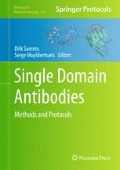Abstract
High avidity, pentameric, single-domain antibodies, oligomerized through the B subunit of verotoxin, are excellent immunohistochemical reagents. The resulting molecules are termed pentabodies. Here, we describe the immunostaining of tissue sections with ES1, a pentabody recognizing CEACAM6 which is overexpressed in several cancers. The advantages of pentabodies, compared to conventional antibody reagents, in immunohistochemical studies are highlighted.
Access this chapter
Tax calculation will be finalised at checkout
Purchases are for personal use only
References
Taussig MJ et al (2007) ProteomeBinders: planning a European resource of affinity reagents for analysis of the human proteome. Nat Methods 4:13–17
Dübel S et al (2010) Generating recombinant antibodies to the complete human proteome. Trends Biotechnol 28:333–339
Zhang J et al (2004) Pentamerization of single-domain antibodies from phage libraries: a novel strategy for generation of high-avidity antibody reagents. J Mol Biol 335:49–56
Zhang J et al (2004) A pentavalent single-domain antibody approach to tumor antigen discovery and the development of novel proteomics reagents. J Mol Biol 341:161–169
Mai KT et al (2006) ES1, a new lung carcinoma antibody – an immunohistochemical study. Histopathology 49:515–522
Blumenthal RD et al (2007) Expression patterns of CEACAM5 and CEACAM6 in primary and metastatic cancers. BMC Cancer 7:2
Duxbury MS et al (2004) CEACAM6 is a determinant of pancreatic adenocarcinoma cellular invasiveness. Br J Cancer 91:1384–1390
Tanha J et al (2002) Selection by phage display of llama conventional VH fragments with heavy chain antibody VHH properties. J Immunol Methods 263:97–109
Bryant RJ, Banks PM, O’Malley DP (2006) Ki67 staining pattern as a diagnostic tool in the evaluation of lymphoproliferative disorders. Histopathology 48:505–515
Du MZ et al (2004) TTF-1 expression is specific for lung adenocarcinoma in typical and atypical carcinoids: TTF-1-positive carcinoids are predominantly in peripheral location. Hum Pathol 35:825–831
Kononen J et al (1998) Tissue microarrays for high-throughput molecular profiling of tumor specimens. Nat Med 4:844–847
Jantscheff P et al (2003) Expression of CEACAM6 in resectable colorectal cancer: a factor of independent prognostic significance. J Clin Oncol 21:3638–3646
Revets H, De Baetselier P, Muyldermans S (2004) Nanobodies as novel agents for cancer therapy. Expert Opin Biol Ther 5:111–124
Acknowledgments
We thank Jianbing Zhang for providing the rabbit anti-verotoxin antiserum. The authors declare no financial conflict of interest.
Author information
Authors and Affiliations
Corresponding author
Editor information
Editors and Affiliations
Rights and permissions
Copyright information
© 2012 Springer Science+Business Media, LLC
About this protocol
Cite this protocol
Maik, K.T., MacKenzie, C.R. (2012). Application of Single-Domain Antibodies in Tumor Histochemistry. In: Saerens, D., Muyldermans, S. (eds) Single Domain Antibodies. Methods in Molecular Biology, vol 911. Humana Press, Totowa, NJ. https://doi.org/10.1007/978-1-61779-968-6_33
Download citation
DOI: https://doi.org/10.1007/978-1-61779-968-6_33
Published:
Publisher Name: Humana Press, Totowa, NJ
Print ISBN: 978-1-61779-967-9
Online ISBN: 978-1-61779-968-6
eBook Packages: Springer Protocols

